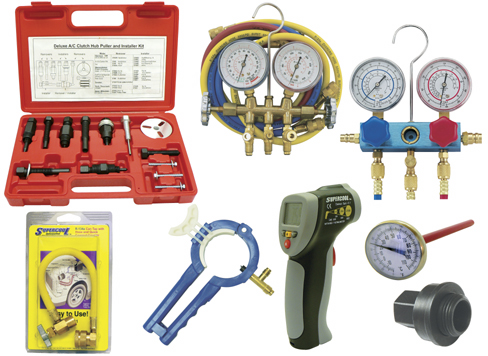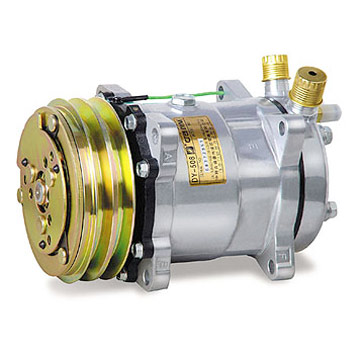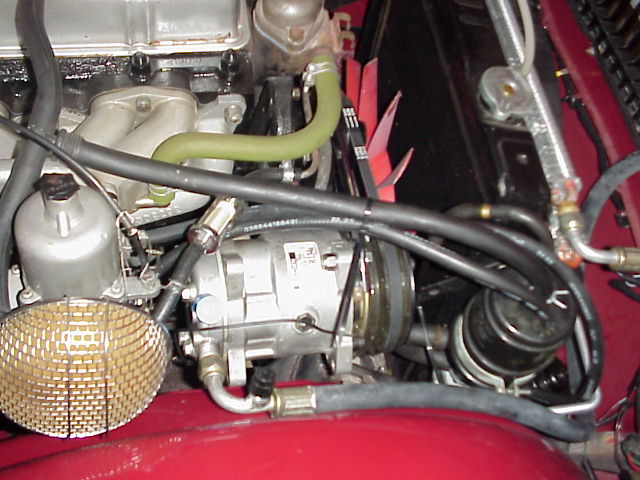| What's Hot! | Products/ Tools | EFI Tuning | Basic Tuning | Advanced Tuning | Chassis Tuning | Advertise with us |
A/C Compressor
Contributed By:MacKayla W.



The A/C compressor is considered one of the most important parts of the air conditioning system. It’s a lot like a human heart in that it pumps the refrigerant throughout the system. If it’s damaged the whole system is affected. How this system works is almost exactly like a fridge.

The compressor is driven by a belt attached to the vehicle’s engine which is engaged by an electromagnetic clutch called the compressor clutch. This is right behind the radiator. When the clutch is engaged the compressor pumps the refrigerant, R-134a or R12, throughout the closed loop system. It starts by compressing the low-pressure gas from the inlet side into a high pressure/temperature gas. The temperature is achieved by taking heat out of the air. This hot gas is then discharged into the condenser (located in front of the radiator) on the low-pressure side. The low-pressure cools the gas and from there it goes to the evaporator and kicks out cold air into a car. The process then starts all over again.
The air conditioning system can over heat the motor if not installed right. Depending on the size of your motor the A/C compressor needs to be in high or low drive. If it’s a bigger motor and it’s in low it could possibly do some damage to the drive belt and the compressor.
For more information, another author at enginebasics.com wrote the following:
The A/C compressor ironically sucks refrigerant into an area of low pressure created by varying methods depending on the type of pump system ( such as pistons, scroll vacuum, and rotary vanes) it is then compressed, and actually despite popular belief makes the temperature rise, extracting heat from the rest of the car rather than blowing cool air. In a piston model a swash plate moves multiple pistons back and forth. A scroll compressor has 2 coils one fixed and the other rotating around in a fixed polar fashion. It is the Freon in the high-pressure area that causes this change in temperature; the two main kinds of Freon are CFC, HFC. After being compressed the hot Freon goes through the radiator, and then the evaporating canister or evap can for short, causing it to quickly expand and lose heat crazy quick.
Rotary vanes consist of a rotor with a number of blades inserted in radial slots in the rotor. The rotor is mounted offset in a larger housing, which can be circular, or a more complex shape. As the rotor turns, blades slide in and out of the slots keeping contact with the outer wall of the housing. The rotating blades create a series of decreasing volumes. Rotary Vane compressors are, with piston compressors one of the oldest of compressor technologies.
The A/C compressor is activated by an electronic clutch. When the a/c is switched on a drum inside the belt pulley is magnetized attracting and locking the belt drive into place making it so that only when engaged does it add extra resistance.
It can explode if there’s not enough refrigerant or due to high pressure, a few examples: "Make no mistake about it, yes they can explode. One of my techs had an r22 system that blew the whole side of the compressor apart and completely covered the side of the homeowner’s house with oil. I have never had it happen to me in more than 20 years in the field, but have seen the end result"- peanut5, "Especially during maintenance. My poor Maintenance guy had ours explode on him while he was trying to install it. Burned the eyebrows right off the poor guy!" - both of these are from yahoo answers.
Also the clutch can have problems, anything from just sticking to ripping itself apart due to centrifugal force. They can slip because they wear out, they can even eat the belt. When repairing you’re A/C compressor remember that most companies will give you a core charge for your old unit, so don’t just take it off and throw it away. Bring it with you to the parts store when picking up the new unit.
Hopefully this gives you a small idea of what an automotive A/C compressor is, and how it works. Be sure to check out more articles here in enginebasics.com
ATTENTION READER:
If you enjoyed the information and article you just read be sure to check out our newly released book with even more exciting photo's and information:How to Turbocharge and Tune your Engine

Want to know more about your particular Make and Model vehicle? All of these vehicles are covered in the tech, maintenance and repair articles found above. Enginebasics is the wiki or wikipedia of car part, repair, how to and tuning information. Let us be the class 101 for your automotive learning.
| Ford | General Motors GM | Pontiac | Jaguar | Land Rover | Nissan |
| Toyota | Honda | Lexus | Acura | Lotus | Scion |
| Infinity | BMW | Mercedes | Mitsubishi | Ferrari | Maserati |
| Lamborghini | Volks Wagen VW | Saab | Audi | Hyundai | Kia |
| Subaru | Mazda | Chevy | Volvo | Caddilac | Dodge |
| Chrylser | Daewoo | Porsche | Mercury | Freightliner | MG |
Individual Models
| Ford Mustang | Mitsubishi Eclipse | Mitsubishi Evo | Subaru WRX / STI | Dodge Viper | Chevrolet Corvette |
| Nissan Skyline | Honda S2000 | Nissan 350z | Toyota Supra | Chevy Camaro | Lotus Elise Exige |
| Honda Civic | VW Golf | Dodge SRT-4 | Eagle Talon | Acura Integra | BMW M3 |
| Nissan 240sx | Porsche 911 | Acura NSX | Honda Accord | Toyota Camry | Toyota MR2 |
| VW R32 | Dodge Truck | Mazda Rx7 | VW Jetta | Sand Buggy | Nissan Sentra |
For the latest Automotive news and stories visit the websites below |
Our feature Build: An AWD V6 Civic




